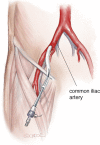Art of operative techniques: treatment options in arch penetrating aortic ulcer
- PMID: 31463216
- PMCID: PMC6687965
- DOI: 10.21037/acs.2019.07.06
Art of operative techniques: treatment options in arch penetrating aortic ulcer
Abstract
Penetrating aortic ulcer (PAU) of the arch has a focal extent which often represents an adequate anatomic target for thoracic endovascular aortic repair (TEVAR). However, the anatomic constraints represented by the supra-aortic vessels pose either clinical or technical challenges that increase when the PAU develops proximally in the arch. Currently, different types of endografts are commercially available and have been used to treat aortic arch lesions. These include branched/fenestrated endografts for a total endovascular approach, and standard devices that can be used in combination with open/hybrid surgical operations, with the aim to exploit the minimally invasive nature of TEVAR by extending the proximal landing zone when necessary. We describe several current techniques adopted in such settings.
Keywords: Penetrating aortic ulcer (PAU); hybrid aortic arch repair; surgical options; thoracic endovascular aortic repair (TEVAR).
Conflict of interest statement
Conflicts of Interest: Dr. Trimarchi is speaker and consultant for Gore (W.L. Gore; Flagstaff, AZ, USA) and Medtronic (Medtronic, Inc.; Minneapolis, MN, USA).
Figures






